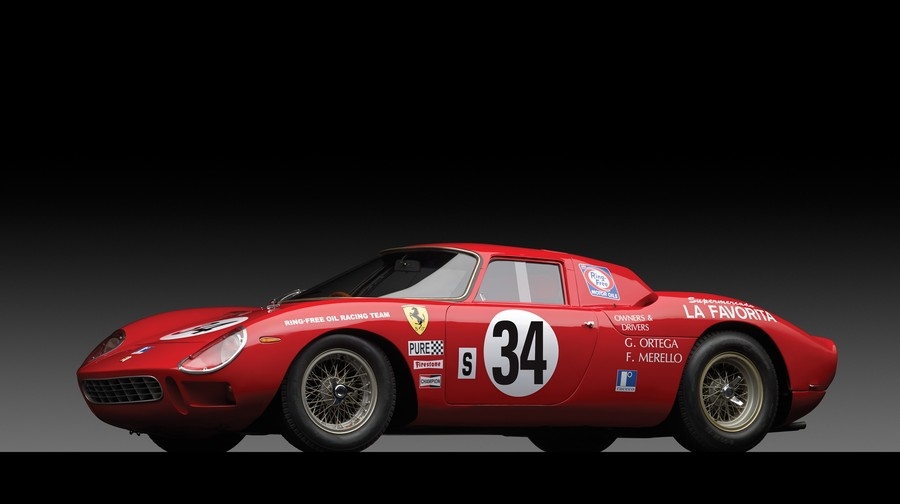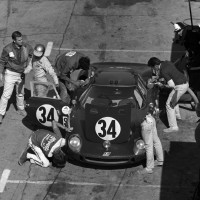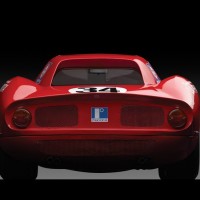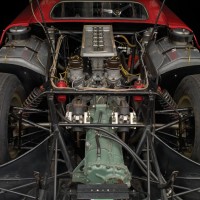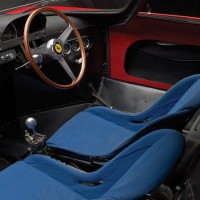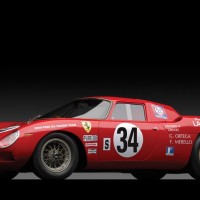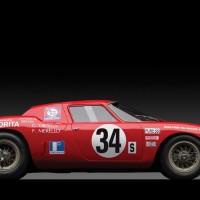SCM Analysis
Detailing
| Vehicle: | 1964 Ferrari 250 LM |
| Number Produced: | 32 |
| Original List Price: | $17,000 |
| Chassis Number Location: | Welded tag on right rear frame tube |
| Engine Number Location: | Right rear of block on side |
| Club Info: | Ferrari Owners Club |
| Website: | http://www.ferrariownersclub.com |
This car, Lot 141, sold for $14,300,000, including buyer’s premium, at RM and Sotheby’s “Art of the Automobile” auction at Sotheby’s New York on November 21, 2013.
Technological advance is inevitable. A newer car is always, by definition, better than what it replaces, but in the subjective areas of soul, joy, and fun, the truism “something’s gained, but something’s lost” can apply far too clearly.
Take the Ferrari 250 LM: It was designed, built, and sold as the true successor to the 250 GTO, and it is by almost any objective criteria a better car — it’s certainly a whole chunk faster — but it never has and never will even approach the desirability of the cars that came before. Let’s consider why.
Mid-engined cars race onto the scene
The mid-engined revolution in racing-car design was started rather by accident by Cooper in the mid-1950s: The tiny little formula racers that a normal Englishman could afford in those days used motorcycle engine/transmission units, and there was no way to put them in the front and still steer, so they got put behind the driver.
It turned out to be a wonderful solution, so as Cooper became successful and started building larger and more serious cars, it seemed appropriate to stay with the mid-engined concept (not exclusively, by the way; Cooper built many front-engined racers in the early days).
By the end of the 1950s, the writing was more than on the wall — it was flashing neon. The future of the racing automobile was a mid-engined design. By 1961, even that most famously conservative of racing-car manufacturers — Ferrari — had committed to mid-engined racers, although only Formula cars to start. This was the era of 1.5-liter Formula One, so the cars were light little things that ran on smooth courses and thus didn’t have to deal with the chassis dynamics that sports racing cars with larger engines and more weight imposed.
Ferrari proceeded carefully with the 246SP, basically a widened Formula One chassis with a 2.4-liter engine, and over the next few years refined the concept — eventually stretching a 6-cylinder chassis by about four inches to make room for the V12 Testa Rossa engine. Ferrari introduced this new car as the Ferrari 250 P in the spring of 1963.
The 250 P was immediately successful, combining the horsepower and reliability of the Testa Rossa V12 with the centralized weight distribution and much more efficient frontal profile and aerodynamics that the mid-engined layout allowed. It was, however, a prototype racer, sort of by definition a very limited-production factory team car to challenge for the championship.
Hello, LM
The Ford-Ferrari wars were just coming to the serious stages. The 1963 GTO had proven to be a formidable weapon against Ford’s Cobras, but it was starting to show its age, and Ford was introducing their mid-engined GT40 for the Grand Touring championship.
Ferrari needed something to up their game if they expected to stay in front. The logical answer: Put a roof on the 250 P, install a bigger engine, and convince the FIA that it was in fact a “production” GT car (50-car minimum production). Enter the 250 LM, which was named 250 in spite of having a 275 engine in hopes of convincing the FIA that it was merely a development of the GTO line (the 1964 GTOs carried the same roof line as the LM in another attempt to maintain visual continuity).
Having been badly burned with the “GT Omologato” (homologated) GTO — 36 produced vs. 50 needed by the rules — the FIA was having none of it, and the LM ended up running in Prototype GT instead of Grand Touring, but it was welcome to run, and that is what mattered.
The 250 LM proved to be very successful over the next several years. It was a worthy successor to the GTO, not least because there were a lot of good ones on race grids. Unlike a “factory team” P car, if you had the money you could go buy one. They built 32 of them, and a few even masqueraded as street cars.
Rat racing in Southern California
A young Steve Earle plunked down $17,000 and bought our subject car with no thought of actually racing it. Saying that he — and subsequent owner Chris Cord — used it as a street car is a bit misleading. The car never went to the grocery store. Instead, it got used for rat racing in Los Angeles — down Sunset Boulevard (those were the days) and over Mulholland Drive. The car also scorched roads to Willow Springs and blistered the Nevada back roads of a far simpler time. A few thousand miles over two years isn’t what most of us think of as street use.
Although he had a fabulous time, even Steve doesn’t claim that the LM was a comfortable or easy car for road use, and it was certainly nothing as nice as the TRs and GTOs he had the pleasure of “street driving” over the years.
The driver is set well forward with his feet squeezed to the center to stay inside the front wheelwells, so you sit at an angle. With the engine between your shoulder blades and a straight-cut 5-speed dog box howling, the LM feels much tighter and noisier inside than the earlier cars, and the multi-plate clutch is a disaster if you need to slip it at all.
The suspension is pure racing car, with zero-compliance heim joints rather than rubber-bushed pickups, and the settings are appropriate for flat-out on a smooth track rather than the occasional real world whoopdies and pavement joints of even good public roads.
Better, but less desirable
In short, even though the 250 LM is the legitimate successor to the Testa Rossas and GTOs that preceded it, it is a vastly different and — from the standpoint of a contemporary collector/user — far less desirable option than its predecessors. Michael Sheehan’s observation about the driving experience is that while a TR or GTO can make a mediocre driver look and feel like a great one, the LM makes a great driver look very busy and a mediocre one look embarrassed.
Somewhere deep in their souls, the TRs and GTOs retain a comfort and drivability that reflect the idea that they were built as open-road racers, while the LM came at a different time. Road and track diverged forever somewhere in the early ’60s, and the LM is really only comfortable and happy being driven flat out on a closed circuit.
This divergence is reflected in market values that seem to peak with the GTO — the last and most advanced arguably streetable racing Ferrari — with the Testa Rossas climbing in value from the earliest ones through the later versions that bookended the series.
The mid-engined cars — single-purpose track weapons that they are — struggle to carry more than half the value assigned to the more streetable GTO and Testa Rossa.
With GTOs apparently now commanding close to $50 million, and TRs somewhere a bit under half that (if any were for sale), it seems to me that the LM should sit somewhere about half the TRs to a bit less. Our subject car is an excellent and relatively original car with few stories, but it has very little of the competition provenance that is required for truly top-market value. All in all, I think that — were I able to choose — I’d be happier to have been the seller of this car than the buyer. I’d say it was well sold. ♦
(Introductory description courtesy of RM Auctions.)
